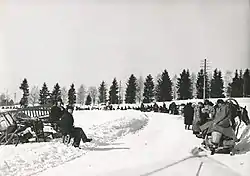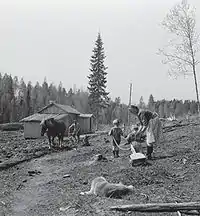
As a result of the 1940 Moscow Peace Treaty that concluded the Winter War, Finland ceded a portion of Finnish Karelia along with other territories to the Soviet Union. As a result, about 410,000 people,[1] or 12% of Finland's population, were relocated to the remaining parts of Finland.[2]
The treaty did not require Finland to empty the ceded territory, but few were willing to stay, and almost the whole population chose to relocate, taking their belongings with them. Only the buildings and machinery were to be left behind intact as per the Peace Treaty, which for the most part also took place.
During the Continuation War, some 260,000 of the displaced population returned home.[3] In June 1944, Finnish troops partially withdrew from the ceded areas again as a result of the Soviet Fourth strategic offensive. Simultaneously, the population was again evacuated.

The Paris Peace Treaty finally confirmed the loss of Finland's territory. The evacuees were permanently settled in Finland. The government of Finland subsidized the resettlement in two ways:
- Resettlers were subsidized. Families were allocated land in proportion to their former property. In addition, everyone evacuated from Finnish Karelia was given the right to receive a homestead and city-dwellers and business-owners were given monetary compensation. The right to homestead was also extended to war veterans, widows and orphans of war.
- Private owners of the land given to resettlers were monetarily compensated for the loss of real estate.
Since the 1990s, some associations have demanded the return of Finnish Karelia to Finland.
See also
References
- ↑ Karjalainen siirtoväki. Yle Teema. Retrieved 2009-07-28. (in Finnish)
- ↑ Wuorinen, John H. (1948). "The Finnish Treaty". The Annals of the American Academy of Political and Social Science. 257: 87–96. doi:10.1177/000271624825700110. ISSN 0002-7162. JSTOR 1026636. S2CID 144773418. Retrieved 8 January 2022.
- ↑ "An OSS Report on Wartime Population Changes in the Baltic", Lithuanian Quarterly J. on Arts and Sci. Vol. 27, No. 3, 1981
External links
- Virtanen, P. V. Asutustoiminta itsenäisessä Suomessa. Maankäyttö 1/2006. (in Finnish)